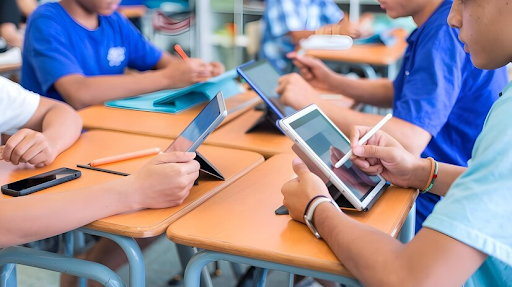Did you know that nearly 30% of students in middle schools struggle with the transition to junior high and affect their school performance? This critical stage in high school can feel overwhelming for both kids and parents within the educational environment of school systems. Navigating new social dynamics in schools, academic pressures at this age, and personal changes is no small feat, as the school mean can shift the meaning of these experiences. Understanding what to expect can make all the difference. In this post, we’ll dive into essential tips and strategies to ease the journey through junior high schools at this age and what school mean for your house. Whether you’re a student or a supportive parent navigating what schools mean for your house, we’ve got insights that will help you tackle this exciting yet challenging phase together.
Role of Technology in Education
Digital Tools
Digital tools house enhance the learning experience in junior high schools. Educational technology integrates seamlessly into the curriculum. Teachers use various technology tools to engage students. For example, interactive whiteboards allow for dynamic lessons. These tools encourage participation and collaboration among students.
Online Resources
Online resources provide diverse educational materials. Students can access a wealth of information beyond textbooks. Websites and apps offer videos, articles, and interactive exercises. This variety caters to different learning styles. It helps students grasp complex concepts more easily.
Learning Management Systems
Learning management systems (LMS) streamline classroom management. Teachers in schools can organize assignments, track progress, and communicate with students efficiently in the house. LMS platforms create a centralized hub to house all course materials for schools. They simplify administrative tasks in schools, allowing educators to focus on teaching in the house.
Educational Technologies
Modern educational technologies play a crucial role in shaping the educational system in schools and house. The educational technology market continues to grow rapidly. Schools are investing in instructional technology to improve outcomes. Adopting these tools prepares students for future challenges.
Learning Solutions
Learning solution technologies address specific educational needs. They include personalized learning plans and adaptive assessments. These solutions help identify areas where students may struggle. Tailored interventions support individual growth and development.
Benefits of Technology for Students
Access to Resources
Technology provides access to information beyond traditional textbooks. Students in schools can explore online databases, e-books, and educational websites. This access broadens their knowledge base significantly. For example, schools and platforms like Khan Academy offer free courses on various subjects.
Interactive Learning
Engagement increases with interactive and multimedia content. Videos, simulations, and educational games capture students’ attention. These tools make learning enjoyable and effective. Research indicates that students in schools retain more information when they interact with the material.
Adaptive Solutions
Technology supports varied learning styles through adaptive solutions. Some students learn better visually in schools, while others prefer auditory methods. Tools like speech-to-text software assist those in schools who struggle with writing. Programs such as Google Classroom allow schools and teachers to tailor assignments to individual needs.
Strong Technology Skills
Developing strong technology skills is essential in today’s world. Students who use technology effectively in schools are better prepared for future careers. Employers often seek candidates from schools who are tech-savvy and adaptable. By integrating technology into education, schools equip students for success.
Summary of Benefits
- Access to diverse resources
- Increased engagement through interactivity
- Support for different learning styles
- Development of essential technology skills
Enhancing Collaboration and Communication
Group Projects
Collaboration thrives in junior high through group projects. Teachers in schools can utilize collaborative software like Google Workspace or Microsoft Teams. These platforms allow students to work together efficiently. They can share documents in schools, brainstorm ideas, and track progress in real time. This enhances productivity and promotes engagement among peers.
Real-Time Communication
Communication plays a crucial role in education. Messaging apps like Remind or Slack enable direct contact between students and teachers in schools. Quick feedback fosters understanding and supports learning. Students in schools feel more comfortable asking questions outside of class hours. This immediate access helps clarify doubts and encourages participation.
Peer-to-Peer Learning
Peer-to-peer learning is essential in junior high. Discussion forums and online groups in schools create spaces for students to interact. They can share resources in school, exchange ideas, and provide support to each other. Such engagement deepens their understanding of various subjects. It also builds a sense of community within the school classroom.
Effective implementation of these tools transforms the learning experience. The importance of collaboration and communication cannot be overstated. Engaging content through technology in school prepares students for a connected world. As they develop these skills in school, they become more equipped for future challenges.
Personalized Learning for All
Tailored Assessments
Data-driven assessments play a crucial role in personalized learning in school. They help educators identify each student’s strengths and weaknesses. This information allows teachers to create customized learning paths. These paths align with individual needs in school, enhancing classroom learning experiences.
Adaptive Educational Apps
Educational apps now adapt to student progress. These school tools provide real-time feedback and adjust lessons accordingly. Students can engage with content that matches their skill levels. This flexibility fosters a more effective learning environment.
Self-Paced Learning
Self-paced learning is essential for students. Online modules and resources allow children to learn at their own speed. They can revisit challenging concepts without pressure. This approach encourages deeper understanding of the material.
Innovative Learning Solutions
Innovative learning solutions are transforming education. Online education settings offer diverse learning opportunities. Students can access classroom lessons from anywhere, making education more accessible. Mobile learning further extends these opportunities, allowing learners to engage with educational content on-the-go.
Enhanced Engagement
Personalizing learning increases student engagement. When lessons resonate with individual interests, motivation rises. Engaged students are more likely to succeed in their studies.
Challenges Schools Face with Technology
Unequal Access
Schools encounter significant challenges regarding unequal access to technology. Not all students have laptops or reliable internet at home. This gap creates disparities in learning opportunities. Students without access often struggle to keep up with their peers. For example, a 2020 report by the Pew Research Center highlighted that 15% of U.S. households with school-age children lacked high-speed internet.
Curriculum Integration
Integrating new technologies into existing curricula poses another challenge. Teachers must adapt their lesson plans to incorporate tools like virtual classrooms and additional technology. This requires training and support, which many schools lack. As a result, some educators may feel overwhelmed. They might resist using modern classrooms effectively.
Cybersecurity Threats
Cybersecurity is a pressing concern in today’s educational landscape. Schools face threats such as data breaches and phishing attacks. Protecting student data is crucial for maintaining trust. In 2021, the K-12 Cybersecurity Resource Center reported over 400 cyber incidents in educational institutions. These threats highlight the need for robust security measures.
Overcoming Resource and Training Issues
Professional Development
Ongoing professional development is crucial for teachers. New technologies emerge rapidly. Educators need training to effectively use these tools. Regular workshops can enhance their skills. This improves classroom engagement and student learning.
Partnerships
Seeking partnerships with tech companies can provide valuable resources. Collaborations can lead to access to cutting-edge tools. Companies often offer support in the form of training or software updates. These partnerships can alleviate some financial burdens on schools.
Budget Allocation
Allocating budgets specifically for technology upgrades is essential. Schools should prioritize funding for new resources and maintenance. This ensures that the latest educational tools are available. Investing in technology directly impacts student success. A well-equipped classroom fosters a better learning environment.
Addressing Concerns
Concerns about resource availability persist. Many schools struggle with outdated equipment. Addressing these issues requires strategic planning and community involvement. Engaging stakeholders helps create effective solutions.
Impact of Technology
The impact of technology on education cannot be overstated. It enhances learning experiences and prepares students for future challenges. Access to quality educational resources empowers both teachers and students. Effective use of technology leads to improved academic outcomes.
Preparing Students for Future Careers
Coding Skills
Educators must incorporate coding and digital skills into the curriculum. These skills are essential in today’s job market. Many careers now require a basic understanding of programming. Schools should offer courses that teach these skills early on. This prepares students for future jobs.
Real-World Applications
Internships provide students with exposure to real-world applications of technology. Schools can partner with local businesses to create internship opportunities. This allows students to apply their classroom learning in a professional setting. They gain valuable experience and insight into potential career paths.
Critical Thinking
Technology-based projects encourage critical thinking and problem-solving. Educators can design assignments that require students to use technology creatively. For instance, group projects using software tools can enhance collaboration skills. This approach helps students learn how to tackle complex problems effectively.
Student Engagement
Engaging students in these ways boosts overall student performance. When students see the relevance of their education, they become more motivated. This engagement leads to better retention of knowledge and skills needed for future careers.
Fostering Digital Literacy and Innovation
Evaluating Sources
Students must learn to evaluate online sources. Digital literacy includes identifying credible information. They should check the author’s credentials and the publication date. This skill helps distinguish between reliable content and misinformation.
Encouraging Creativity
Creativity thrives through digital storytelling. Students can use digital learning tools for multimedia projects. These projects allow them to express ideas in innovative ways. Incorporating games into lessons further enhances engagement. It fosters inquisitiveness and motivates students to explore topics deeply.
Responsible Technology Use
Understanding digital footprints is crucial. Students need to recognize the impact of their online actions. Promoting responsible use of technology prepares them for future challenges. They should practice safe browsing habits and respect others online. This awareness aligns with the goals outlined by the World Economic Forum for developing global leaders.
Collaboration and Communication
Collaboration tools enhance group projects. Students can work together on assignments from different locations. This experience prepares them for a connected world. Communication skills are essential in both academic and professional settings.
Lifelong Learning
Adopting a mindset of lifelong learning is vital. The digital landscape evolves rapidly, requiring continuous adaptation. Students who embrace this will thrive in their careers.
Final Remarks
Technology is reshaping junior high education in ways we never imagined. It opens doors to personalized learning, enhances collaboration, and prepares students for the future. Yet, challenges like resource gaps and training needs can’t be ignored. Schools must tackle these issues head-on to fully harness tech’s potential.
You play a crucial role in this journey. Advocate for better resources, support teachers, and encourage students to embrace digital literacy. Together, you can foster an environment where innovation thrives. So, let’s roll up our sleeves and make tech work for everyone in your community. The future is bright, and it starts with you!At Mapúa Malayan Colleges Mindanao, we’re committed to empowering students and educators alike. Contact us today to learn how we can work together to enhance education through technology.


